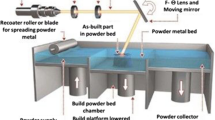Abstract
A numerical approach has been developed based on the stream function technique and the finite element analysis to predict required power and temperature rise in wire drawing processes. An admissible velocity field is first proposed using a stream function and then power consumption in the wire drawing is optimized to achieve sensible and unique deformation geometry. In addition, the finite element method together with axi-symmetric Petrov–Galerkin algorithm is coupled with the deformation model to assess the temperature distribution in both the deforming wire and the die during the process. The work hardening effects are also considered in the model both in the deformation zone and on the velocity discontinuity surfaces. The model can estimate the effects of various process parameters such as drawing velocity and die geometry. In order to evaluate the results of the model, the predictions are compared with the established models including force equilibrium as a lower-bound approach and an upper-bound solution based on the spherical velocity field.
Similar content being viewed by others
References
Osakada K (2010) History of plasticity and metal forming analysis. J Mater Process Technol 210:1448–1449
Fietier N, Krahenbuhl Y, Vialard M (2009) New methods for the fast simulations of the extrusion process of hot metals. J Mater Process Technol 209:2244–2259
Richmond O, Morrison HL (1967) Streamlined wire drawing dies of minimum length. J Mech Phys Solids 15:195–203
Hoysan SF, Steif PS (1992) A streamline-based method for analyzing steady state metal forming processes. Int J Mech Sci 34:211–221
Padmanabhan KA, Vasin RA, Enikeev FU (2001) Superplastic flow: phenomenology and mechanics, 352nd edn. Springer, Heidelberg, pp 206–208
Richmond O, Devenpeck ML (1962) “A die profile for maximum efficiency in strip drawing”, Proceedings of the Fourth U.S. National Congress of Applied Mechanics ASME, New York, 2:1053–1057
Yang DY, Han CH, Lee BC (1985) The use of generalized deformation boundaries for the analysis of axisymmetric extrusion through curved dies. Int J Mech Sci 27:653–663
Maity KP, Kar PK, Das NS (1996) A class of upper-bound solutions for the extrusion of square shapes from square billets through curved dies. J Mater Process Technol 62:185–190
Panteghini A, Genna F (2010) An engineering analytical approach to the design of cold wire drawing processes for strain-hardening materials. Int J Mater Form 3:279–289
Avitzur B, Hahn WC, Iscovici S (1975) Limit analysis of flow through conical converging dies. J Franklin Inst 299:339–358
Avitzur B, Narayan C, Chou YT (1982) Upper-bound solutions for flow through conical converging dies. Int J Mach Tool Des Res 22:197–214
Kumar S, Prasad SK (2004) Feature-based design of extrusion process using upper-bound and finite element techniques for extrudable shapes. J Mater Process Technol 155:1365–1372
Ajiboye JS, Adeyemi MB (2008) Effects of extrusion variables on temperature distribution in axisymmetric extrusion process. Int J Mech Sci 50:522–537
Gusel L, Anžel I, Brezocnik M (2005) Effect of lubrication on the stress distribution in an extruded material. Int J Adv Manuf Technol 25:288–291
Heinrich JC, Pepper DW (1999) Intermediate finite element method, fluid flow and heat transfer applications. Taylor & Francis, Philadelphia, pp 313–347
Zienkiewicz OC, Taylor RL (2000) The finite element method, volume 1: the basis 5th ed. Butterworth-Heinemann, Oxford, pp 39–55
Talbert SH, Avitzur B (1996) Elementary mechanics of plastic flow in metal forming, chapters 3 and 4. Wiley, Chichester
Kemp IP, Pollard G, Beamley AN (1985) Temperature distribution in the high speed drawing of high strength steel wire. Int J Mech Sci 27:803–811
Incropera FP, DeWitt DP, Bergman TL, Lavine AS (2006) Fundamentals of heat and mass transfer, 6th edn. Wiley, New York, p 934
Fueyo JH (1969) “Limit analysis of drawing and extrusion through conical converging dies”, Ph.D. thesis, Dept. of Met. and Mats. Science, Lehigh University
Author information
Authors and Affiliations
Corresponding author
Rights and permissions
About this article
Cite this article
Hosseinabadi, H.G., Serajzadeh, S. A coupled stream function-finite element analysis for wire drawing processes. Int J Adv Manuf Technol 57, 917–926 (2011). https://doi.org/10.1007/s00170-011-3344-0
Received:
Accepted:
Published:
Issue Date:
DOI: https://doi.org/10.1007/s00170-011-3344-0




